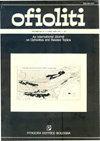Po平原沉积物中蛇绿岩的遗传:重金属分布及风险评价
IF 1.3
4区 地球科学
Q2 GEOLOGY
引用次数: 38
摘要
高重金属背景,特别是铬和镍,在波河平原的土壤和沉积物中是著名的。在地质参考地球化学图的综合分析中,新的XRF数据强调了异常高Cr-Ni背景与波河细粒冲积沉积物有关。通过与波河流域蛇绿岩的风化成分对比,认为其地球化学特征反映了碎屑岩和超泥质岩石风化的沉积成分。因此,Cr-Ni背景升高是波河冲积沉积物的地质特征,与人为污染无关。对铁质矿物的电子探针研究表明,镍主要存在于蛇纹石中(高达0.4 wt%),而铬主要存在于绿泥石中(高达2.5 wt%)。用ICP-MS分析浸出液的萃取试验表明,铬的迁移率是有限的;该地区天然水的浓度普遍低于国家饮用水标准。不幸的是,即使在极低浓度下,这种元素也被认为是有毒和危险的,如果以六价形式氧化,这种形式在表基因条件下普遍存在,从而引起严重的环境问题。另一方面,镍表现出更高的迁移率,可能是由于蛇纹石的亚稳行为。在沉积物和土壤中,Cr/Ni始终高于1,而在该地区的自然水体和农产品中,Cr/Ni始终低于1。因此,高镍浓度代表着进一步的地球化学风险,必须对当地农作物的相对含量进行监测。出于同样的原因,在波河三角洲周围广泛分布的泻湖中开发的贻贝和蛤蜊养殖场等水产养殖活动也可能受到镍生物积累的影响,必须仔细监测相关产品。本文章由计算机程序翻译,如有差异,请以英文原文为准。
OPHIOLITE INHERITANCE IN THE PO PLAIN SEDIMENTS: INSIGHTS ON HEAVY METALS DISTRIBUTION AND RISK ASSESSMENT
High heavy metals backgrounds, in particular chromium and nickel, are renowned in soils and sediments of the Po Plain. New XRF data, synthetized in geo-referenced geochemical maps, emphasize that the anomalously high Cr-Ni backgrounds are related to the fine alluvial sediments of the Po River. A com- parison with the regolith composition of ophiolite rocks cropping out within the Po River basin suggests that the observed geochemical features reflect sedi- mentary components deriving from the weathering of femic and ultrafemic rocks. The elevated Cr-Ni backgrounds are therefore a geogenic character of the Po River alluvial sediments, unrelated to anthropogenic contamination. Electron microprobe investigation focused on femic minerals highlights that nickel is mainly sequestrated in serpentine (up to 0.4 wt%) whereas chromium is mainly hosted in chlorite (up to 2.5 wt%). Extraction tests, in which leachates have been analysed by ICP-MS, reveal that the mobility of chromium is limited; coherently the natural water of the area usually display concentration lower than the national drinking standards. Unfortunately, this element is considered toxic and dangerous even at extremely low concentration if oxidized in the hexava- lent form that is prevalent in supergene conditions, thus posing serious environmental concerns. Nickel, on the other hand, displays a higher mobility, possibly due to the metastable behaviour of serpentine. Coherently the Cr/Ni is always higher than one in the investigated sediments and soils, whereas is always lower than one in both the natural waters and agricultural products of the area. Therefore, the high nickel concentration represents further geochemical risk and the relative content has to be monitored in the local agricultural crops. For the same reasons, aquaculture activities such as mussels and clam farms developed in the lagoons widespread around the delta of Po River are also potentially exposed to nickel bio-accumulation and the related products have to be carefully monitored.
求助全文
通过发布文献求助,成功后即可免费获取论文全文。
去求助
来源期刊

Ofioliti
地学-地质学
CiteScore
2.40
自引率
7.70%
发文量
1
期刊介绍:
Since 1976, Ofioliti provides an international forum for original contributions and reviews in the field of the geodynamics, petrology, geochemistry, biostratigraphy, stratigraphy, tectonics and paleogeography applied to ophiolitic terrains and modern oceanic lithosphere, including their sedimentary cover. Studies of topics such as geodynamics of the mantle, the evolution of orogens including ophiolites and paleoceanography are also welcome
 求助内容:
求助内容: 应助结果提醒方式:
应助结果提醒方式:


